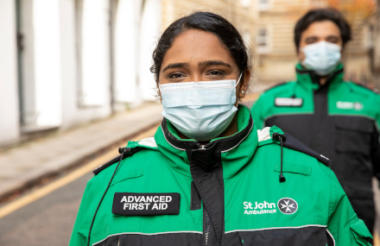Fundraising income at St John Ambulance rose by £2.1m to £19m in 2020, although overall income fell by 10% as other parts of its activity were affected by the pandemic.
The charity’s 2020 annual report for the year-end 31 December 2020 was published this week and shows donations were up to £14.2m from £11.8m.
The £19m in fundraising income also includes £3.9m in legacies, £500,000 in grants not including government Covid-19 support, and £400,000m in youth subscriptions.
The accounts read: “We’ve seen the generosity of the donors and the growing fundraising commitment of St John people deliver increases in revenue.
“Many of our volunteers unable to engage with their normal activities have helped increase the reach of our fundraising, whilst decisions in 2019 to invest in fundraising have made a huge difference to our performance in 2020.”
In 2020 the charity also launched Always St John, in-memory fundraising. There are three key parts to this, tributes, funeral collection and a dedication garden.
The charity received a total of 116 complaints about its fundraising activities in 2020, more than double the 55 complaints in 2019.
Around half of the complaints resulted in training or retraining of the individual fundraiser.
Overall income down 10%
St John Ambulance’s pandemic work supporting the NHS in hospitals brought in £4.4m and its ambulance income rose by a quarter to £16m.
Despite the rise in fundraised income, the charity’s overall income was down 10% to £92.2m. Operational free reserves were £18.3m, down from £27.1m in 2019.
This was partially because income for first aid training was only half of the £46.8m generated in 2019, at £23.4m.
In addition, the charity’s work providing first aid cover at public events and running youth activities dropped 71% to £2.1m.
St John Ambulance reported an overall operating deficit of £7.9m, up from £7.1m the previous year.
The charity's operational free reserves are £18.3m, down from £27.1m in 2019.
Redundancies and cost-cutting measures
The charity received a government grant of £6.8m, from a nationwide pot of £750m, and an emergency appeal raised £3.2m.
It also made use of the furlough scheme, which contributed £4.8m towards wage costs.
The annual report also shows cost-cutting measures helped to bring down total expenditure by £8.7m to £99.1m.
The accounts read: “Whilst some additional revenue was secured, the reality of our financial position meant it was necessary to bring in a series of other measures, with the speed of our response supported by a regular subgroup meeting of finance trustees and senior executives.”
This led to a freeze on recruitment and projects and meant a large amount of staff were made redundant.
Over the year there were 181 redundancies. In addition, 30 posts were removed as staff transferred across from its training enterprise to its ambulance operations following re-training.
Payments to employees in relation to termination of employment during the year totalled £3.3m.
In 2019, this was £0.7m, and the charity attributes the rise in payments to redundancy payments.
To further shore up its finances, the charity arranged a £10m bank loan, which it did not use, and took £5m cash from investments. It also sold four properties.
The annual salary of the chief executive as of 31 December 2020 was £133,650.
Related articles
Martin Houghton-Brown: ‘St John Ambulance saw its income dry up, and we went to the NHS and offered to help’
Martin Houghton-Brown, chief executive of St John Ambulance, tells Kirsty Weakley about how the charity expanded its services to help with the pandemic response, and the lasting impact it will have











